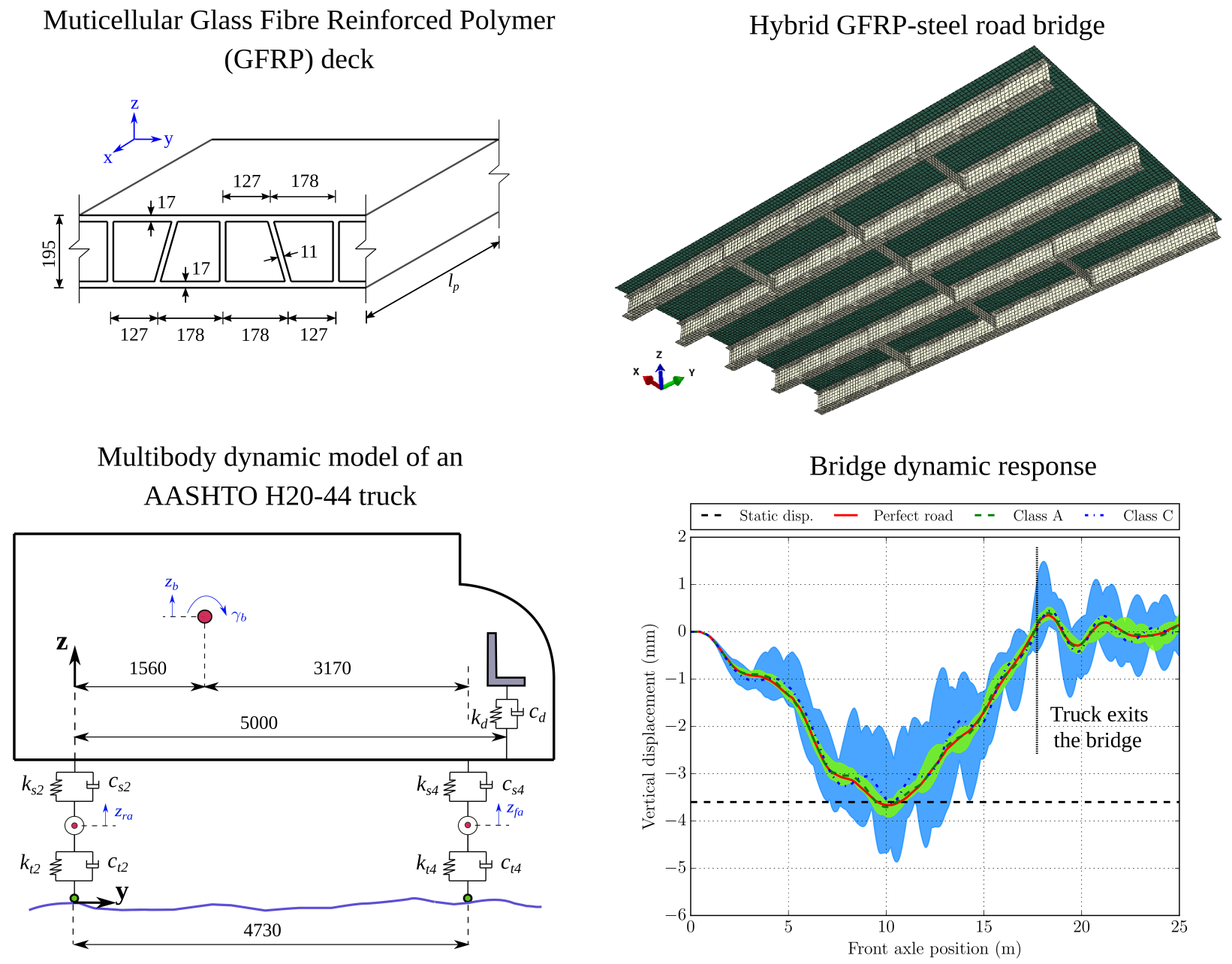Influence of the Properties of a Glass Fiber Reinforced PolymerDeck on the Dynamic Response of a Road Bridge
##plugins.themes.bootstrap3.article.main##
Abstract
##plugins.themes.revistapolitecnica.stadistisDownloadTitle##
Downloads
Article Details
References
AASHTO (2012). AASHTO LRFD Bridge Design Specifications. American Association of State Highway and Transportation Officials
Alqam, M., Bennett, R. M., and Zureick, A. H. (2002). Threeparameter vs. two-parameter Weibull distribution for pultruded composite material properties. Composite Structures, 58(4), 497–503. https://doi.org/10.1016/S0263-8223(02)00158-7
Aluri, S., Jinka, C., and GangaRao, H. (2005). Dynamic Response of Three Fiber Reinforced Polymer Composite Bridges. Journal of Bridge Engineering, 10(6), 722–730. https://doi.org/10.1061/(ASCE)1084-0702(2005)10:6(722)
ISO (2016). ISO 8608: Mechanical Vibrations - Road Surface Profiles - Reported Of Measured Data. International Organization for Standardization, Geneva.
Jiang, X., Ma, Z., and Song, J. (2013). Effect of shear stud connections on dynamic response of an FRP deck bridge under moving loads. Journal of Bridge Engineering, 18(7), 644–652. https://doi.org/10.1061/(ASCE)BE.1943-5592.0000401
Joint Research Centre (2016). Prospect for new guidance in the design of FRP. European Commission, Ispra. https://publications.jrc.ec.europa.eu/repository/handle/JRC99714
Keelor, D., Luo, Y., Earls, C., and Yulismana, W. (2004). Service load effective compression flange width in fiber reinforced polymer deck systems acting compositely with steel stringers. Journal of Composites for Construction, 8(4), 289–297. https://doi.org/10.1061/(ASCE)1090-0268(2004)8:4(289)
Kim, Y. (2019). State of the practice of FRP composites in highway bridges. Engineering Structures, 179, 1–8. https://doi.org/10.1016/j.engstruct.2018.10.067
Lee, S., Hong, K., and Park, S. (2010). Current and Future Applications of Glass-Fibre-Reinforced Polymer Decks in Korea. Structural Engineering International, 20(4), 405–408. https://doi.org/10.2749/101686610793557672
Mara, V. and Haghani, R. (2015). Review of FRP decks: structuraland in-service performance. Proceedings of the Institution of Civil Engineers - Bridge Engineering, 168(4), 308–329. https://doi.org/10.1680/bren.14.00009
Mara, V., Haghani, R., and Harryson, P. (2014). Bridge decks of fibre reinforced polymer (FRP): A sustainable solution. Construction and Building Materials, 50, 190–199. https://doi.org/10.1016/j.conbuildmat.2013.09.036
Marchesiello, S., Fasana, A., Garibaldi, L., and Piombo, B. (1999). Dynamics of multi-span continuous straight bridges subject to multi-degrees of freedom moving vehicle excitation. Journal of Sound and Vibration, 224(3), 541–561. https://doi.org/10.1006/jsvi.1999.2197
Oliva, J., Goicolea, J., Antolín, P., and Astiz, M. (2013). Relevance of a complete road surface description in vehicle-bridge interaction dynamics. Engineering Structures, 56, 466–476. https://doi.org/10.1016/j.engstruct.2013.05.029
Qiao, P., Davalos, J. F., and Brown, B. (2000). A systematic analysis and design approach for single-span FRP deck/stringer bridges. Composites Part B: Engineering, 31(6-7), 593–609. https://doi.org/10.1016/S1359-8368(99)00044-X
Resins, B. D. D. C. (2009). LCA Composietbrug Eindrapport (2e versie). Technical report, BECO Group, Rotterdam.
Sayers, M. (1988). Dynamic terrain inputs to predict structural integrity of ground vehicles. Technical report, University of Michigan, Transportation Research Institute, Michigan.
SIMULIA (2020). Abaqus 2020 Analysis User’s Guide. Dassault Systèmes Simulia Corporation.
Wan, B., Rizos, D., Petrou, M., and Harries, K. (2005). Computer simulations and parametric studies of GFRP bridge deck systems. Composite Structures, 69(1), 103–115. https://doi.org/10.1016/j.compstruct.2004.05.012
Zhang, Y., Cai, C., Shi, X., and Wang, C. (2006). VehicleInduced Dynamic Performance of FRP versus Concrete Slab Bridge. Journal of Bridge Engineering, 11(4), 410–419. https://doi.org/10.1061/(ASCE)1084-0702(2006)11:4(410)
Zuo, L. and Nayfeh, S. (2007). H2 optimal control of disturbancedelayed systems with application to vehicle suspensions.
Vehicle System Dynamics, 45(3), 233–247. https://doi.org/10.1080/00423110600884288




